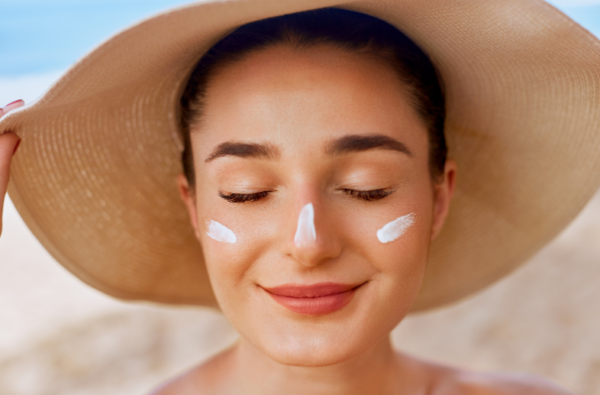Summer is a time for fun in the sun. But you need to protect your skin this summer for all those hours spent soaking up the sun’s rays, it’s can cause serious damage to your skin if you’re not careful.
Protecting your skin from the sun is crucial to avoid sunburn, premature aging of the skin, wrinkles, spots, and even skin cancer.
This comprehensive guide will provide you with the best tips and strategies to keep your skin safe, healthy, and glowing this summer.
Understanding the Impact of Summer on Your Skin
The summer season can be harsh on your skin due to prolonged exposure to UV rays. Sunburn, heat rash, and acne breakouts are common skin issues during this time.
Additionally, excessive sweating can lead to clogged pores and skin irritation.
It’s crucial to understand the impact of summer on your skin to implement the right skincare routine.
So our first big pro tips for you are to stay hydrated and drink 2 liters of water at least to give your skin all the hydration it wants and sleep well so you can conquer the world in the morning with your summer fun activities and adventure.
8 Tips to Protect Your Skin This Summer

8 Tips to Protect Your Skin This Summer
The best tips from our guide on how to protect your skin this summer.
Don’t worry about the heat and sun we got you covered, you can enjoy all your summer activities and plans with great skin texture and without any thoughts about your skin health.
Let’s dive into our top tips for the best skin sun protection this summer.
1. Use Sunscreen Frequently and Liberally
The first and most important line of defense for your skin is sunscreen.
Sunscreen is important to protect your skin this summer. Apply a broad-spectrum sunscreen with a Sun Protection Factor (SPF) of at least 30.
SPF refers to the amount of UVB protection a sunscreen provides from burning rays.
Make sure to apply sunscreen generously 15-30 minutes before going outside, even on slightly cloudy or overcast days.
The sun’s harmful UV rays can penetrate through clouds.
Reapply sunscreen every two hours when outdoors or immediately after sweating or swimming, even if the sunscreen is water-resistant.
According to dermatologist recommendations, most people apply only 25-50% of the recommended amount of sunscreen.
- Apply enough sunscreen to fill a shot glass for proper coverage of exposed areas.
- Don’t forget oft-missed spots like the tops of your feet, behind your neck, ears, and lips.
- Apply sunscreen any time you are outdoors, not just when at the pool or beach.
- Choose a sunscreen that provides broad-spectrum protection, meaning it blocks both UVA and UVB rays.
- UVA rays penetrate deeply into the skin and cause premature aging. UVB rays burn the surface of the skin.
- Look for sunscreens with zinc oxide or avobenzone for the best UVA protection.
- For outdoor summer activities like swimming, water sports, or exercise, use a water-resistant sunscreen with an SPF of at least 50.
- Towel dry instead of completely removing sunscreens.
- Apply sunscreen even on cloudy or cool days whenever outside.
2. Cover Up with Protective Clothing and Accessories
In addition to sunscreen, wear protective clothing and accessories for full sun protection.
Hats with a wide brim of at least 3 inches provide excellent shade and protection for the face, ears, scalp, and neck.
It’s crucial to cover your body with protective clothes to protect your skin this summer.
Baseball caps don’t provide enough coverage so opt for floppy hats, straw hats with a brim, or legionnaire hats with a flap in the back.
- Look for lightweight, loose-fitting shirts and pants made of densely woven fabric like Coolmax or high-thread count cotton.
- UPF or UV protective clothing has built-in protection from the sun’s rays.
- Wear UV-blocking sunglasses to prevent damage around the eyes which can lead to cataracts.
- Seek shade whenever possible under umbrellas, trees, or other shelters.
- Use a sun-protective beach tent or gazebo when at the park, lake, or beach.
- Keep infants under 6 months out of direct sunlight completely.
- Apply sunscreen and have older babies wear hats and UV-protective swimwear.
3. Schedule Outdoor Activities Carefully
- Pay close attention to timing when planning outdoor summer activities.
- The sun’s ultraviolet rays are strongest and most intense from 10 am to 4 pm.
- Limit time outside during these peak sun hours.
- Seek shade breaks regularly if you must be outdoors midday.
- The sun can still damage skin early morning and late afternoon so don’t neglect protection during off-peak hours.
If your shadow is shorter than you are, the damaging rays are at their strongest.
Watch the UV index which rates the intensity of the sun’s rays on a scale of 1 to 11+. When the index is 6 or higher, full sun protection is needed.
Pay attention to local weather forecasts so you can plan outdoor time accordingly.
Avoid direct sun exposure as much as possible between mid-morning and late afternoon when rays are strongest.
4. Skip the Tanning Beds
Avoid tanning beds at all costs. Tanning beds give off UVA rays much stronger than the midday sun, speeding up photoaging and wrinkles.
Just one indoor tanning session increases the risk of melanoma by 20% and the risk increases with each additional use. The UV rays from tanning beds are classified as human carcinogens by the World Health Organization.
There is no such thing as a ‘safe tan.’
5. Eat Photoprotective Foods

Healthy foods to protect your skin this summer
Some foods have photoprotective properties to help fortify your skin against sun damage from the inside out. Healthy food help to protect your skin this summer.
- Make sure your diet includes plenty of antioxidants, healthy fats, and photoprotective nutrients.
- Fruits and vegetables with vitamin C like citrus, berries, kiwi, tomatoes, broccoli, and red bell peppers boost collagen production.
- Carotenoids like beta-carotene found in carrots, sweet potatoes, and apricots provide antioxidant effects.
- Green tea contains ECGC polyphenols that protect against UV damage and reduce inflammation.
- Fatty fish like salmon and mackerel deliver skin-smoothing omega-3s.
- Walnuts and avocados provide healthy fats.
- Dark chocolate has flavanols shown to shield against sun harm in some studies.
A healthy, whole foods diet lays the groundwork for photoprotection. But external sunscreen remains
necessary for adequate protection. Don’t count on food alone to prevent a burn.
6. Apply After-Sun Skin Treatments
If you do end up getting a sunburn, act quickly to promote healing, ease discomfort and minimize damage.
Take an over-the-counter pain medication like ibuprofen to reduce inflammation.
Apply soothing aloe vera gel or hydrocortisone cream to prevent peeling and moisturize burnt skin.
Take cool baths using unscented soaps or bath salts to provide relief without irritating the skin. Apply a thick, fragrance-free moisturizer after bathing to replenish moisture and aid healing. Drink plenty of water and avoid alcohol to help your body recover faster.
Over-the-counter antihistamines can help relieve itching as the burn heals.
Do not pop blisters that may form which can lead to infection. Avoid hot showers or baths, harsh soap, and scrubbing which can further irritate the damaged skin.
Seek medical attention immediately for severe burns with fever, chills, blistering, or extreme pain. Signs
of infection include increased pain, swelling, oozing, redness, and heat requiring antibiotic treatment.
While peeling skin after a burn is unsightly, it is a natural healing process as your body sheds the damaged layers.
Let the peeling occur naturally and avoid picking or peeling the skin yourself.
Use gentle cleansers without soap and apply soothing moisturizers as needed until the burn fully resolves.
7. Check Your Skin Regularly
Frequently examine your skin for any new growths or unusual changes in moles or spots.
Look for warning signs of skin cancer such as asymmetrical shape, irregular borders, evolving size or color, or a diameter greater than a pencil eraser.
Check all over your body including the scalp, between toes, soles of feet, and under nails.
See a dermatologist annually for a full skin cancer screening.
Protect your skin from harmful UV exposure from an early age to minimize lifetime damage. About 90% of nonmelanoma skin cancers are associated with exposure to ultraviolet radiation from the sun.
Checking your skin regularly is important to protect your skin this summer and be safe.
Melanoma is directly linked to excessive UV exposure and sunburns, particularly in childhood. The risk for
melanoma doubles if you have had more than 5 sunburns.
8. Consult Your Dermatologist
Speak with your dermatologist if you have concerns about sun damage, skin cancer risks, or precancerous growths.
They can provide guidance on the best sunscreens, protective clothing, diet, and lifestyle to maintain healthy skin.
Ask about medical treatments to reverse sun damage like laser treatments for pigmentation and signs of aging.
people also ask
It is recommended to apply sunscreen every two hours or more frequently if you're swimming or sweating heavily.
Yes, aloe vera gel can be very soothing and beneficial for sunburned skin. Apply it generously for relief
No, not all sunscreens are reef-safe. Look for products that are labeled reef-safe and free from harmful chemicals like oxybenzone and octinoxate.
Yes, you can wear makeup during the summer, but choose lightweight, non-comedogenic products to avoid clogging pores.
If you notice any persistent or concerning skin issues, it's best to consult a dermatologist to ensure proper diagnosis and treatment. How often should I apply sunscreen during the summer?
Can I use natural remedies like aloe vera for sunburned skin?
Are all sunscreens reef-safe?
Can I wear makeup during the summer without clogging my pores?
Is it necessary to consult a dermatologist for minor skin issues?
Conclusion
In conclusion to our comprehensive guide of how to protect your skin this summer.
Taking care of your skin during the summer is crucial to avoid sun damage, irritation, and other skin concerns.
By adopting a diligent skincare routine and incorporating protective measures, you can enjoy the
sunny season while maintaining healthy and radiant skin.

